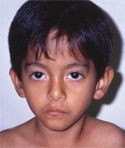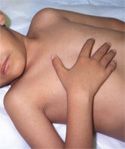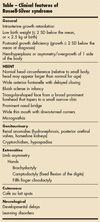Boy With Growth Retardation, Craniofacial Anomalies, and Hemihyperplasia
A 4 1/2 year-old Hispanic boy is referred to the pediatric clinic because of failure to thrive and growth retardation. He was born at full-term in Mexico and weighed 1.9 kg at birth (lower than the 3rd percentile).

A 4 1/2 year-old Hispanic boy is referred to the pediatric clinic because of failure to thrive and growth retardation. He was born at full-term in Mexico and weighed 1.9 kg at birth (lower than the 3rd percentile). He was hospitalized for 1 week immediately after birth because of feeding concerns. His mother reports that he has always been small and has had difficulty in gaining weight. His height and weight are both lower than the 3rd percentile for his age. He has developmental delays in his gross motor and verbal skills.

Physical examination reveals a quiet, small, thin boy. He weighs 12.2 kg (lower than the 3rd percentile) and is 95.3 cm tall (lower than the 3rd percentile). His occipitofrontal circumference is 48.5 cm (25th percentile) and his head appears large in relation to the rest of his body. He has a triangular-appearing face marked by a broad forehead that tapers into a hypoplastic midface with a narrow small chin. His eyes have an anti-mongoloid slant. His mouth is wide and thin with the corners downturned. He also has hemihyperplasia; the left side of his body appears larger than the right. A leg length discrepancy is evident: the right leg is shorter than the left by 3/4 of an inch. Fifth finger clinodactyly is present on both hands. A caf au lait spot is seen on his anterior chest wall.
High-resolution chromosome analysis is normal (46,XY) and results of tests for serum amino acids are negative.
TO WHAT GENETIC DISORDER DOES THIS PROFILE POINT?
(Answer and discussion begin on the next page.)
ANSWER:
RUSSELL-SILVER SYNDROME
This young boy has the growth retardation and clinical features described in patients with Russell-Silver syndrome (RSS). This genetic syndrome has been categorized as a recognizable pattern of malformation of very small stature without skeletal dysplasia.1 Synonyms are Silver-Russell syndrome, Silver syndrome, Russell syndrome, Russell-Silver dwarfism, and Silver-Russell dwarfism.2 This syndrome is characterized by intrauterine growth retardation that persists as postnatal growth deficiency, characteristic craniofacial features, and body asymmetry.2,3
ETIOLOGY AND PREVALENCE
Although rare, RSS is one of the more common genetic syndromes encountered by pediatricians and has a wide phenotypic variation. The phenotype was described independently by Silver and Russell in the early 1950s.1 Initially not thought to be a genetic disorder because of its rare occurrence within families, molecular analysis has demonstrated heritable and spontaneous mutations in patients with an RSS phenotype.4 The risk for passing on the disorder to offspring depends on the type of mutation in patients with RSS. Spontaneous rearrangements have been demonstrated on chromosomes 1,7 (especially at band 7p11.2), and 17.2,4,5 Genomic imprinting seems to be involved in generating the RSS phenotype because about 10% of patients have inherited both copies of chromosome 7 from their mother (maternal uniparental disomy).6-8 Single-gene mutations have also been demonstrated in RSS, showing autosomal dominant, autosomal recessive, and X-linked dominant inheritance. The last form of RSS is quite rare and is called Russell-Silver syndrome, X-linked (Partington syndrome).2,4,5
To date, more than 400 cases of RSS have been reported worldwide. A wide range of prevalence is reported, from 1 in 3000 to 1 in 100,000 births.3 Current literature cites a prevalence of 1 in 100,000 births.8 The syndrome occurs equally in girls and boys and does not vary among ethnic groups.6,9
CLINICAL FEATURES

Intrauterine growth retardation marked by low birth weight and short length, later accompanied by postnatal growth deficiency, is characteristic of the disorder. 2,8 Hemihyperplasia is present in 65% to 80% of affected newborns.2,5 Feeding difficulties that can lead to hypoglycemia in the newborn period are common. GI symptoms, such as gastroesophageal reflux disease, esophagitis, and food aversion, may be present, leading to failure to thrive.3,6,7 Nighttime sweating along with a grayness or pallor of the skin has also been described in infants.3,10 Precocious sexual development may occur in older children.3,4,7
The clinical features of RSS are listed in the Table.1,6-11
DIAGNOSIS AND TREATMENT
For patients with RSS, the goals of treatment are to optimize nutritional growth, maximize stature, and address developmental delays/learning disabilities. These goals are accomplished with the aid of many medical specialists under the coordinated care of a pediatric primary care provider. Consultation with a gastroenterologist and nutritionist is needed to maximize caloric intake, optimize weight gain, and prescribe feeding therapies. Occupational therapists can assist in correcting food aversion behaviors. If genitourinary pathology is present, referral to an urologist and/or nephrologist is indicated. Orthopedists and physical therapists address limb discrepancies and difficulties with ambulation. Developmental specialists and speech therapists focus on learning disorders and language impairments.8,9
Specialized growth and height curves are available for patients with RSS.3 Once the patient has reached school age, evaluation by a pediatric endocrinologist is indicated to see whether he or she is a candidate for growth hormone therapy.6 Although the growth velocity of most patients is normal, growth hormone therapy has been successful in improving growth and increasing height in patients with RSS.8,10 Adverse effects from growth hormone treatments include an increase in muscle tone, increased risk of glucose intolerance or diabetes, and irregular bone growth.10 The greatest height benefit from growth hormone therapy is evident during the first 5 years of treatment.3 The patient in this case was treated with somatropin starting at age 6. The response has been very positive.
PROGNOSIS
Given the rarity of RSS, there are no long-term studies that clearly define life expectancy, morbidity, or mortality issues. Affected patients are thought to have a normal life expectancy and are capable of leading independent and productive lives. As patients age, the characteristic phenotype becomes less pronounced.8,11 Psychosocial concerns can arise related to speaking and learning difficulties and to short stature.
A LESSON FOR THE CLINICIAN
RSS can be diagnosed at birth. Other possible causes of prenatal and postnatal growth retardation, such as fetal alcohol syndrome and Fanconi syndrome, should be considered.11 Support groups and organizations such as the Human Growth Foundation, Little People of America, the MAGIC Foundation for Children’s Growth, and Silver-Russell Support Group (Box), are invaluable resources not just for patients with RSS and their caregivers but also for medical personnel seeking to learn about the phenotypic and genotypic variations of this syndrome.2,8,9
Online Educational Resources and Support Groups for Parents and Children With Russell-Silver Syndrome
References:
REFERENCES:
1.
Jones KL. Russell-Silver syndrome (Silver syndrome). In: Jones KL, ed.
Smith's Recognizable Patterns of Human Malformation.
5th ed
.
Philadelphia: WB Saunders; 1997:96-99.
2.
National Organization for Rare Disorders: Russell-Silver syndrome (RSS). Available at: http://www.rarediseases.org/search/rdbdetail_abstract.html? disname=Russell%20Silver%20Syndrome%20%28RSS%29. Accessed June 26, 2007.
3.
Russell Silver Syndrome/Intrauterine Growth Foundation. Available at: http://www.childgrowthfoundation.org/Russell%20Silver%20Syndrome% 20-%20Interuterine%20Growth%20Retardation.htm. Accessed June 26, 2007.
4.
The Magic Foundation: Russell-Silver Syndrome--General Information. Available at: www.magicfoundation.org/www/docs/112/russell_silver_ syndrome.html. Accessed June 26, 2007.
5.
A-Z Health Guide from WebMD: Health Topics: Russell-Silver Syndrome (RSS). Available at: www.webmd.com/hw/health_guide_atoz/nord377.asp? printing=true. Accessed June 26, 2007.
6.
Medline Plus: Medical Encyclopedia: Russell-Silver syndrome. Available at: www.nlm.nih.gov/medlineplus/print/ency/article/001209.htm. Accessed June 26, 2007.
7.
Russell-Silver Syndrome; RSS; Silver-Russell Dwarfism. Available at: www.ncbi.nlm.nih.gov/entrez/dispomim.cgi?cmd=entry&id=180860. Accessed June 26, 2007.
8.
Russell-Silver Syndrome. Available at: www.geneclinics.org/servlet/ access?db=geneclinics&site=gt&id=8888890&key=JzabNoKzUWCG4&gry= &fcn=y&fw=Drh0&filename=/profiles/rss/index.html. Accessed June 26, 2007.
9.
eMedicine: Silver-Russell Syndrome. Available at: www.emedicine.com/ PED/topic2099.htm. Accessed June 26, 2007.
10.
Silver-Russell dwarfism. Available at: en.wikipedia.org/wiki/Russell-Silver_ syndrome. Accessed June 26, 2007.
11.
Silver-Russell Syndrome. Available at: www.patient.co.uk/showdoc/40001427. Accessed June 26, 2007.
Recognize & Refer: Hemangiomas in pediatrics
July 17th 2019Contemporary Pediatrics sits down exclusively with Sheila Fallon Friedlander, MD, a professor dermatology and pediatrics, to discuss the one key condition for which she believes community pediatricians should be especially aware-hemangiomas.




















